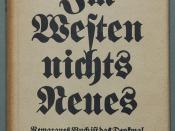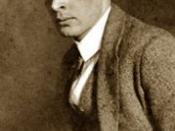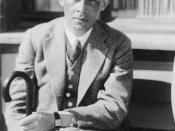Erich Maria Remarque's All Quiet on the Western Front, a novel set in World War I, centers around the changes wrought by the war on one young German soldier. During his time in the war, Remarque's protagonist, Paul Baumer, changes from a rather innocent Romantic to a hardened and somewhat caustic veteran. More importantly, during the course of this metamorphosis, Baumer disaffiliates himself from those societal icons-parents, elders, school, religion-that had been the foundation of his pre-enlistment days. This rejection comes about as a result of Baumer's realization that the pre-enlistment society simply does not understand the reality of the Great War. His new society, then, becomes the Company, his fellow trench soldiers, because that is a group which does understand the truth as Baumer has experienced it.
Tolstoy's war and peace describes the different classes of Russian society in the terms of their participation in the war and what kind of an impact war had on their lives.
In the beginning of the novel, the Russian aristocratic class, which was in the czar's circle, wanted Russia to participate in the war. They wanted a quick victory and pride for the Russian nobility. They did not anticipate that the war would destroy homes, agriculture, and take many Russian lives. There are the good people, and of course, the bad. The good people being Natasha Rostov, a teenage girl who grows and matures throughout the book and Pierre Bezuhov, the son of Kirill Vladmirovitch Bezuhov, who speaks much of the novel expressing his purpose on earth.
Prince Andrei Bolkonsky, the leader of the Bolkonsky family and a great war hero. The bad people are the protagonists themselves, as they torment themselves and Napoleon Bonaparte, the emperor and military leader of France, whom is bent on world domination. The aristocrats,


